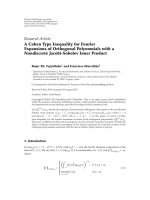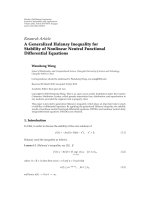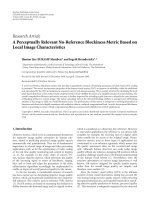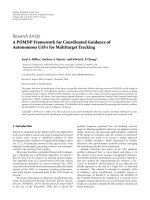Báo cáo hóa học: " Research Article A Reverse Hardy-Hilbert-Type Inequality Gaowen Xi" pot
Bạn đang xem bản rút gọn của tài liệu. Xem và tải ngay bản đầy đủ của tài liệu tại đây (476.46 KB, 7 trang )
Hindawi Publishing Corporation
Journal of Inequalities and Applications
Volume 2007, Article ID 79758, 7 pages
doi:10.1155/2007/79758
Research Article
A Reverse Hardy-Hilbert-Type Inequality
Gaowen Xi
Received 12 December 2006; Accepted 12 March 2007
Recommended by Lars-Erik Persson
By estimating the weight coefficient, a reverse Hardy-Hilbert-type inequality is proved.
As applications, some equivalent forms and a number of particular cases are obtained.
Copyright © 2007 Gaowen Xi. This is an open access article distributed under the Cre-
ative Commons Attribution License, which permits unrestricted use, distribution, and
reproduction in any medium, provided the original work is properly cited.
1. Introduction
Let p>1, 1/p+1/q
= 1, a
n
≥ 0, b
n
≥ 0, and 0 <
∞
n=0
a
p
n
< ∞,0<
∞
n=0
b
q
n
< ∞. Then the
Hardy-Hilbert inequality is as follows:
∞
n=0
∞
m=0
a
m
b
n
m +n +1
<
π
sin(π/p)
∞
n=0
a
p
n
1/p
∞
n=0
b
q
n
1/q
, (1.1)
where the constant factor π/sin(πp) is the best possible [1].
For (1.1), Yang et al. [2–6] gave some strengthened versions and extensions as follows:
∞
n=0
∞
m=0
a
m
b
n
m +n +1
<
∞
n=0
π −
7
5(
√
n +3)
a
2
n
∞
n=0
π −
7
5(
√
n +3)
b
2
n
1/2
(1.2)
∞
n=0
∞
m=0
a
m
b
n
m +n +1
<
∞
n=0
π
sin(π/p)
−
ln2 −C
(2n +1)
1+1/p
a
p
n
1/p
×
∞
n=0
π
sin(π/p)
−
ln2 −C
(2n +1)
1+1/q
b
q
n
1/q
,
(1.3)
2 Journal of Inequalities and Applications
where ln2
−C =0.1159315
+
(C is the Euler constant),
∞
n=0
∞
m=0
a
m
b
n
(m + n +1)
λ
<B
p + λ −2
p
,
q + λ
−2
q
∞
n=0
n +
1
2
1−λ
a
p
n
1/p
×
∞
n=0
n +
1
2
1−λ
b
q
n
1/q
,
(1.4)
where the constant B((p + λ
−2)/p,(q + λ −2)/q) is the best possible (2 −min{p, q} <
λ
≤ 2),
∞
n=0
∞
m=0
a
m
b
n
(m + n +1)
λ
<B
λ
p
,
λ
q
∞
n=0
n +
1
2
p−1−λ
a
p
n
1/p
×
∞
n=0
n +
1
2
q−1−λ
b
q
n
1/q
,
(1.5)
where the constant B(λ/p, λ/q) is the best possible (0 <λ
≤ min{p, q}),
∞
n=0
∞
m=0
a
m
b
n
(m + n +1)
λ
<B
(r −2)t + λ
r
,
(s
−2)t + λ
s
∞
n=0
n +
1
2
p(1−t+(2t−λ)/r)−1
a
p
n
1/p
×
∞
n=0
n +
1
2
q(1−t+(2t−λ)/s)−1
b
q
n
1/q
,
(1.6)
where the constant B(((r
−2)t + λ)/r,((s − 2)t + λ)/s) is the best possible (r>1, 1/r +
1/s
= 1, t ∈[0, 1], 2−min{r, s}t<λ≤2 −min{r, s}t +min{r, s}).
For the reverse Hardy-Hilbert inequality, recently, Yang [7]gaveareverseformofin-
equalities (1.4), (1.5), and (1.6)forλ
= 2. The main objective of this paper is to establish
an extension of the above Yang’s work for 1.5 <λ<3, by estimating the weight coefficient.
For this, we need the following expression of the β function B(p,q) (see [8]):
B(p,q)
= B(q, p) =
∞
0
1
(1 + u)
p+q
u
p−1
du,(p, q>0) (1.7)
and the following inequality [3]:
∞
0
f (x)dx +
1
2
f (0) <
∞
m=0
f (m) <
∞
0
f (x)dx +
1
2
f (0)
−
1
12
f
(0), (1.8)
where f (x)
∈ C
3
[0, ∞), and
∞
0
f (x)dx < ∞,(−1)
n
f
(n)
(x) > 0, f
(n)
(∞) = 0(n = 0,1,2,3).
Gaowen Xi 3
2. Main results
Lemma 2.1. Let N
0
be the set of nonnegative intege rs, N the set of positive integers, and R
the set of real numbers. The weight coefficient ω
λ
(n) is defined by
ω
λ
(n) =
∞
m=0
1
(m + n +1)
λ
, n ∈ N
0
,1.5 ≤ λ<3. (2.1)
Then
2(n +1)
2−λ
(λ −1)(2n +3−λ)
1 −
(λ −1)
2
4(n +1)
2
<ω
λ
(n) <
2(n +1)
2−λ
(λ −1)(2n +3−λ)
. (2.2)
Proof. If n
∈ N
0
,let f (x) = 1/(m + n +1)
λ
, x ∈ [0, ∞). By (1.8), we obtain
ω
λ
(n) >
∞
0
dx
(x + n +1)
λ
+
1
2(n +1)
λ
=
1
(λ −1)(n +1)
λ−1
+
1
2(n +1)
λ
,
ω
λ
(n) <
∞
0
1
(x + n +1)
λ
dx +
1
2(n +1)
λ
+
λ
12(n +1)
λ+1
=
1
(λ −1)(n +1)
λ−1
+
1
2(n +1)
λ
+
λ
12(n +1)
λ+1
.
(2.3)
Since we find
1
(λ −1)(n +1)
λ−1
+
1
2(n +1)
λ
2(n +1)
λ−1
−(λ −1)(n +1)
λ−2
=
2
λ −1
−
λ −1
2(n +1)
2
,
1
(λ −1)(n +1)
λ−1
+
1
2(n +1)
λ
+
λ
12(n +1)
λ+1
2(n +1)
λ−1
−(λ −1)(n +1)
λ−2
=
2
λ −1
−
2λ −3
6(n +1)
2
−
λ(λ −1)
12(n +1)
3
.
(2.4)
Then we obtain
1
(λ −1)(n +1)
λ−1
+
1
2(n +1)
λ
=
2(n +1)
2−λ
(λ −1)(2n +3−λ)
1 −
(λ −1)
2
4(n +1)
2
,
1
(λ −1)(n +1)
λ−1
+
1
2(n +1)
λ
+
λ
12(n +1)
λ+1
=
2(n +1)
2−λ
(λ −1)(2n +3−λ)
×
1 −
(2λ −3)(λ −1)
12(n +1)
2
−
λ(λ −1)
2
24(n +1)
3
.
(2.5)
Since for 1.5
≤ λ<3, 2(n +1)
2−λ
/(λ −1)(2n +3−λ) > 0, (2λ −3)(λ −1)/12(n +1)
2
≥ 0,
λ(λ
−1)
2
/24(n +1)
3
> 0, then we have (2.2). The lemma is proved.
4 Journal of Inequalities and Applications
Theorem 2.2. Let 0 <p<1, 1/p+1/q
= 1, 1.5 ≤ λ<3,anda
n
≥ 0, b
n
> 0, such that 0 <
∞
n=0
((n +1)
2−λ
a
p
n
/(2n +3−λ)) < ∞, 0 <
∞
n=0
((n +1)
2−λ
b
q
n
/(2n +3−λ)) < ∞. Then
∞
n=0
∞
m=0
a
m
b
n
(m + n +1)
λ
>
2
λ −1
∞
n=0
(n +1)
2−λ
2n +3−λ
1 −
(λ −1)
2
4(n +1)
2
a
p
n
1/p
×
∞
n=0
(n +1)
2−λ
2n +3−λ
b
q
n
1/q
.
(2.6)
Proof. By the reverse H
¨
older inequality [9], we have
∞
n=0
∞
m=0
a
m
b
n
(m + n +1)
λ
=
∞
n=0
∞
m=0
a
m
(m + n +1)
λ/p
·
b
n
(m + n +1)
λ/q
≥
∞
m=0
∞
n=0
a
p
m
(m + n +1)
λ
1/p
·
∞
n=0
∞
m=0
b
q
n
(m + n +1)
λ
1/q
=
∞
m=0
ω
λ
(m)a
p
m
1/p
·
∞
n=0
ω
λ
(n)b
q
n
1/q
.
(2.7)
Since 0 <p<1andq<0, then by (2.2), we obtain (2.6). The theorem is proved.
In Theorem 2.2,forλ
= 2, we have the following corollary.
Corollary 2.3. Let 0 <p<1, 1/p+1/q = 1,anda
n
≥ 0, b
n
> 0, such that 0 <
∞
n=0
(a
p
n
/
(2n +1))<
∞, 0 <
∞
n=0
(b
q
n
/(2n +1))< ∞. Then
∞
n=0
∞
m=0
a
m
b
n
(m + n +1)
2
> 2
∞
n=0
1 −
1
4(n +1)
2
a
p
n
2n +1
1/p
∞
n=0
b
q
n
2n +1
1/q
. (2.8)
Remark 2.4. Inequality (2.8) is inequality [7, Inquality (8)]. Hence, inequality (2.6)isan
extension of Yang’s inequality [7, Inquality (8)] for 1 <λ<3.
Theorem 2.5. Let 0<p<1, 1/p+1/q
= 1, 1.5 ≤ λ<3,anda
n
≥ 0, such that 0 <
∞
n=0
((n+
1)
2−λ
a
p
n
/(2n +3−λ)) < ∞. Then
∞
n=0
(n +1)
2−λ
2n +3−λ
1−p
∞
m=0
a
m
(m + n +1)
λ
p
>
2
λ −1
p
∞
n=0
(n +1)
2−λ
2n +3−λ
1 −
(λ −1)
2
4(n +1)
2
a
p
n
.
(2.9)
Inequalities (2.9)and(2.6)areequivalent.
Proof. Let
b
n
=
(n +1)
2−λ
2n +3−λ
1−p
∞
m=0
a
m
(m + n +1)
λ
p−1
, n ∈ N
0
. (2.10)
Gaowen Xi 5
By (2.6), we have
∞
n=0
(n +1)
2−λ
b
q
n
2n +3−λ
p
=
∞
n=0
(n +1)
2−λ
2n +3−λ
1−p
∞
m=0
a
m
(m + n +1)
λ
p
p
=
∞
n=0
∞
m=0
a
m
b
n
(m + n +1)
λ
p
≥
2
λ −1
p
∞
n=0
(n +1)
2−λ
2n +3−λ
1 −
(λ −1)
2
4(n +1)
2
a
p
n
×
∞
n=0
(n +1)
2−λ
b
q
n
2n +3−λ
p−1
.
(2.11)
Then we obtain
∞
n=0
(n +1)
2−λ
b
q
n
2n +3−λ
=
∞
n=0
(n +1)
2−λ
2n +3−λ
1−p
∞
m=0
a
m
(m + n +1)
λ
p
≥
2
λ −1
p
∞
n=0
(n +1)
2−λ
2n +3−λ
1 −
(λ −1)
2
4(n +1)
2
a
p
n
.
(2.12)
If
∞
n=0
((n +1)
2−λ
b
q
n
/(2n +3−λ)) =∞, then in view of
0 <
∞
n=0
(n +1)
2−λ
a
p
n
2n +3−λ
1 −
(λ −1)
2
4(n +1)
2
≤
∞
n=0
(n +1)
2−λ
a
p
n
2n +3−λ
<
∞ (2.13)
and (2.12), we have
∞
n=0
(n +1)
2−λ
2n +3−λ
1−p
∞
m=0
a
m
(m + n +1)
λ
p
>
2
λ −1
p
×
∞
n=0
(n +1)
λ−2
2n +3−λ
1 −
(λ −1)
2
4(n +1)
2
a
p
n
;
(2.14)
if 0 <
∞
n=0
((n +1)
λ−2
b
q
n
/(2n +3−λ)) < ∞,thenby(2.6), we find
∞
n=0
(n +1)
2−λ
2n +3−λ
1−p
∞
m=0
a
m
(m + n +1)
λ
p
>
2
λ −1
p
×
∞
n=0
(n +1)
2−λ
2n +3−λ
1 −
(λ −1)
2
4(n +1)
2
a
p
n
.
(2.15)
Hence we obtain (2.9).
6 Journal of Inequalities and Applications
On the other hand, by the reverse H
¨
older inequality [9], we have
∞
n=0
∞
m=0
a
m
b
n
(m + n +1)
λ
=
∞
n=0
(n +1)
(λ−2)/q
(2n +3−λ)
1/q
∞
m=0
a
m
(m + n +1)
λ
×
b
n
(n +1)
(λ−2)/q
(2n +3−λ)
1/q
≥
∞
n=0
(n +1)
2−λ
2n +3−λ
1−p
∞
m=0
a
m
(m + n +1)
λ
p
1/p
×
∞
n=0
(n +1)
2−λ
b
q
n
2n +3−λ
1/q
.
(2.16)
Hence by (2.9), it follows that
∞
n=0
∞
m=0
a
m
b
n
(m + n +1)
λ
>
2
λ −1
∞
n=0
(n +1)
2−λ
a
p
n
2n +3−λ
1 −
(λ −1)
2
4(n +1)
2
1/p
×
∞
n=0
(n +1)
2−λ
b
q
n
2n +3−λ
1/q
.
(2.17)
Then, (2.9)and(2.6) are equivalent. The theorem is proved.
In (2.9), for λ = 2, we have the following corollary.
Corollary 2.6. Let 0 <p<1, 1/p+1/q =1, a
n
≥ 0, 0 <
∞
n=0
(a
p
n
/(2n +1))< ∞, Then
∞
n=0
(2n +1)
p−1
∞
m=0
a
m
(m + n +1)
2
p
> 2
p
∞
n=0
1 −
1
4(n +1)
2
a
p
n
2n +1
. (2.18)
Inequalities (2.18)and(2.8)areequivalent.
References
[1] G. H. Hardy, J. E. Littlewood, and G. P
´
olya, Inequalities, Cambridge University Press, Cam-
bridge, UK, 2nd edition, 1952.
[2] B. Yang and L. Debnath, “Some inequalities involving π and an application to Hilbert’s inequal-
ity,” Applied Mathematics Letters, vol. 12, no. 8, pp. 101–105, 1999.
[3] B. Yang and L. Debnath, “On a new generalization of Hardy-Hilbert’s inequality and its applica-
tions,” Journal of Mathematical Analysis and Applications, vol. 233, no. 2, pp. 484–497, 1999.
[4] B. Yang, “On a strengthened version of the more precise Hardy-Hilbert inequality,” Acta Mathe-
matica Sinica. Chinese Series, vol. 42, no. 6, pp. 1103–1110, 1999.
[5] B. Yang and T. M. Rassias, “On a new extension of Hilbert’s inequality,” Mathematical Inequalities
&Applications, vol. 8, no. 4, pp. 575–582, 2005.
[6] B. Yang, “On a new extension of Hilbert’s inequality with some parameters,” Acta Mathematica
Hungarica, vol. 108, no. 4, pp. 337–350, 2005.
[7] B. Yang, “A reverse of the Hardy-Hilbert’s type inequality,” Journal of Southwest China Normal
University (Natural Science), vol. 30, no. 6, pp. 1012–1015, 2005.
Gaowen Xi 7
[8] Z. Wang and G. Dunren, An Introduction to Special Function, Science Press, Beijing, China, 1979.
[9] J. Kuang, Applied Inequalities, Sandong Science and Technology Press, Jinan, China, 2004.
Gaowen Xi: Department of Mathematics, Luoyang Teachers’ College, Luoyang 471022, China
Email address:









